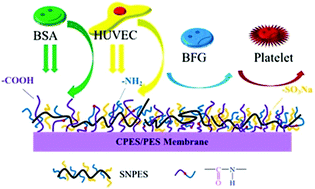当前位置:
X-MOL 学术
›
Biomater. Sci.
›
论文详情
Our official English website, www.x-mol.net, welcomes your
feedback! (Note: you will need to create a separate account there.)
Introducing multiple bio-functional groups on the poly(ether sulfone) membrane substrate to fabricate an effective antithrombotic bio-interface
Biomaterials Science ( IF 5.8 ) Pub Date : 2017-10-25 00:00:00 , DOI: 10.1039/c7bm00673j Lingren Wang 1, 2, 3, 4, 5 , Min He 3, 4, 5, 6, 7 , Tao Gong 1, 2, 3 , Xiang Zhang 3, 4, 5, 6, 7 , Lincai Zhang 1, 2, 3 , Tao Liu 1, 2, 3 , Wei Ye 1, 2, 3 , Changjiang Pan 1, 2, 3 , Changsheng Zhao 3, 4, 5, 6, 7
Biomaterials Science ( IF 5.8 ) Pub Date : 2017-10-25 00:00:00 , DOI: 10.1039/c7bm00673j Lingren Wang 1, 2, 3, 4, 5 , Min He 3, 4, 5, 6, 7 , Tao Gong 1, 2, 3 , Xiang Zhang 3, 4, 5, 6, 7 , Lincai Zhang 1, 2, 3 , Tao Liu 1, 2, 3 , Wei Ye 1, 2, 3 , Changjiang Pan 1, 2, 3 , Changsheng Zhao 3, 4, 5, 6, 7
Affiliation

|
It has been widely recognized that functional groups on biomaterial surfaces play important roles in blood compatibility. To construct an effective antithrombotic bio-interface onto the poly(ether sulfone) (PES) membrane surface, bio-functional groups of sodium carboxylic (–COONa), sodium sulfonic (–SO3Na) and amino (–NH2) groups were introduced onto the PES membrane surface in three steps: the synthesis of PES with carboxylic (–COOH) groups (CPES) and water-soluble PES with sodium sulfonic (–SO3Na) groups and amino (–NH2) groups (SNPES); the introduction of carboxylic groups onto the PES membrane by blending CPES with PES; and the grafting of SNPES onto CPES/PES membranes via the coupling of amino groups and carboxyl groups. The physical/chemical properties and bioactivities were dependent on the proportions of the additives. After introducing bio-functional groups, the excellent hemocompatibility of the modified membranes was confirmed by the inhibited platelet adhesion and activation, prolonged clotting times, suppressed blood-related complement and leukocyte-related complement receptor activations. Furthermore, cell tests indicated that the modified membranes showed better cytocompatibility in endothelial cell proliferation than the pristine PES membrane due to the synergistic promotion of the functional groups. To sum up, these results suggested that modified membranes present great potential in fields using blood-contacting materials, such as hemodialysis and surface endothelialization.
中文翻译:

在聚(醚砜)膜基材上引入多个生物官能团以制造有效的抗血栓形成生物界面
众所周知,生物材料表面的官能团在血液相容性中起着重要作用。为了在聚(醚砜)(PES)膜表面上构建有效的抗血栓形成生物界面,羧酸钠(–COONa),磺酸钠(–SO 3 Na)和氨基(–NH 2)的生物功能基团为通过三个步骤将其引入到PES膜表面:具有羧基(–COOH)基团(CPES)的PES的合成以及具有磺酸钠(–SO 3 Na)和氨基(–NH 2)基团(SNPES)的水溶性PES的合成; 通过将CPES与PES混合将羧基引入PES膜中;和SNPES的接枝到CPES / PES膜通过氨基和羧基的偶联。物理/化学性质和生物活性取决于添加剂的比例。引入生物功能基团后,通过抑制血小板粘附和活化,延长凝血时间,抑制血液相关补体和白细胞相关补体受体的活化,证实了修饰膜的优异血液相容性。此外,细胞测试表明,由于功能基团的协同促进作用,修饰的膜在内皮细胞增殖中比原始的PES膜表现出更好的细胞相容性。综上所述,这些结果表明,改性膜在使用血液接触材料(例如血液透析和表面内皮化)的领域中具有巨大潜力。
更新日期:2017-11-22
中文翻译:

在聚(醚砜)膜基材上引入多个生物官能团以制造有效的抗血栓形成生物界面
众所周知,生物材料表面的官能团在血液相容性中起着重要作用。为了在聚(醚砜)(PES)膜表面上构建有效的抗血栓形成生物界面,羧酸钠(–COONa),磺酸钠(–SO 3 Na)和氨基(–NH 2)的生物功能基团为通过三个步骤将其引入到PES膜表面:具有羧基(–COOH)基团(CPES)的PES的合成以及具有磺酸钠(–SO 3 Na)和氨基(–NH 2)基团(SNPES)的水溶性PES的合成; 通过将CPES与PES混合将羧基引入PES膜中;和SNPES的接枝到CPES / PES膜通过氨基和羧基的偶联。物理/化学性质和生物活性取决于添加剂的比例。引入生物功能基团后,通过抑制血小板粘附和活化,延长凝血时间,抑制血液相关补体和白细胞相关补体受体的活化,证实了修饰膜的优异血液相容性。此外,细胞测试表明,由于功能基团的协同促进作用,修饰的膜在内皮细胞增殖中比原始的PES膜表现出更好的细胞相容性。综上所述,这些结果表明,改性膜在使用血液接触材料(例如血液透析和表面内皮化)的领域中具有巨大潜力。











































 京公网安备 11010802027423号
京公网安备 11010802027423号